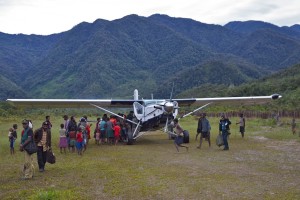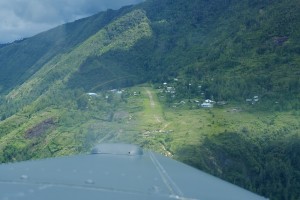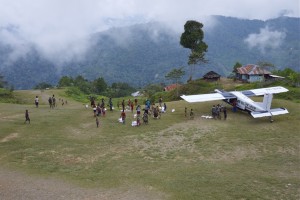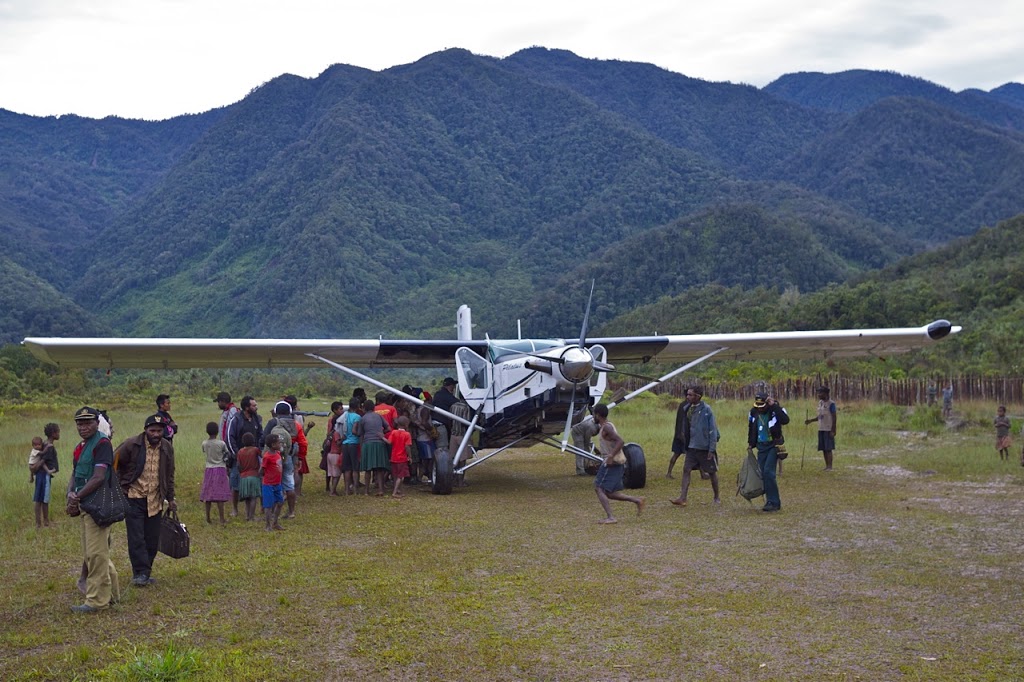 |
| Duma airstrip, Papua |
The evaluation would be a number of flights into various airstrips with Sven in the right hand seat to both observe and guide me on the finer details of mountain flying. Freshly back from a five week break from flying, this was going to be a challenge.
Things didn’t get off to the best of starts. A slightly non-straight landing by me at our very first airstrip, Bilogai, nearly ended in us veering off the side of the runway thanks to a non-functioning left brake. If there’s one thing you need when recovering from a non-straight landing in a tailwheel aircraft, it’s decent braking action on both pedals. A squirt of power to get some airflow over the rudder helped bring us back away from the runway’s edge but it was a pretty scary experience for both of us!
It could only get better from then onwards and it certainly increased the pressure on me to prove myself on subsequent landings. It took me a few days to really get into the swing of things and get comfortable with landing on sloped airstrips and at high altitudes. These two factors were not things I’d done much of before so required learning and practising some different techniques to make safe landings.
 |
| Local people at Modio |
A few of the airstrips we went to had anything from a 10% upslope to 24%. The landing technique we used for these is to flare as usual, but delay reducing the power to idle until you are flying parallel to the runway before reducing to idle and touching down. You then need to keep the momentum up so you can power up the slope and turn around at the top. If you stop, there’s a good chance you’ll get stuck!
 |
| Pogapa – 530m, 5900ft & 16% then 8% upslope |
The altitude of most of the airstrips we went to was around 4-6000ft; there are even higher ones which can be as high as 9000ft apparently! The effect of this is to increase your actual (or true) airspeed over what’s indicated on your instruments. In the Porter, we normally fly the approach at 65kts and decrease to 60kts before touchdown. At sea level, that indicated speed is the same as your actual speed (assuming no wind). At 6000ft, although you are flying at the same indicated speeds, your actual or true airspeed can be 15kts+ higher. And you can really feel that extra speed as you come into a short 300m runway, especially if there’s a tailwind (which there usually is!).
The other, major, consideration is of course the terrain. There’s plenty of it in Papua and a lot of it is above 10,000ft. It’s therefore vitally important that you know where you are at all times and not descend into the wrong valley or go IMC (instrument meteorological conditions i.e. fog) without being 100% sure you are not going to fly into something.
 |
| Bugalaga – 500m, 5700ft & 14%,8% then 24% upslope |
All of that aside, the flying is just awesome and at times incredibly humbling. Descending into a steep valley with huge mountains, stretching thousands of feet above you is truly special. You feel so insignificant in your little aeroplane as you descend towards that tiny airstrip, perched on a slope at the end of the valley. There’s nothing else in aviation that can compare to this.
So, did I pass the evaluation? Well, yes thankfully! And tomorrow I’ll leave Nabire and head to Timika to start flying with the other resident Porter pilot there who’ll show me all the airstrips we go to from there and help get me familiar with the local area. I can’t wait!
 |
| Looking pleased with myself having landed at Dadou (330m, 4300ft & 18% upslope) |
Discover more from Matt Dearden
Subscribe to get the latest posts sent to your email.

Thanks again for sharing Matt. You may not remember me but you helped me loads online during ATPL mod 1 revision. I bombarded you with questions and you were always patient and answered everything! Many many thanks
Fon
Thanks for the kind words Fon. Mod 1 hey? That was a *long* time ago! Hope you’re doing well :o)
Proud to you sir. your one of the hero for my people West Papua. thanks